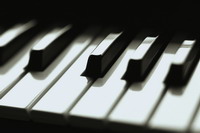Piano Sheets > Ben Bernie Sheet Music > Sweet Georgia Brown (ver. 2) Piano Sheet
Sweet Georgia Brown (ver. 2) by Ben Bernie - Piano Sheets and Free Sheet Music

About the Song
Other avaliable versions of this music sheet: Version 1 Version 2
"Sweet Georgia Brown" is a jazz standard and pop tune written in 1925 by Ben Bernie & Maceo Pinkard (music) and Kenneth Casey (lyrics).
The tune was first recorded in 1926 by bandleader Ben Bernie, resulting in a five-week No. 1 for Ben Bernie & his Hotel Roosevelt Orchestra.[1] As Bernie's then nationally famous orchestra featuring the number did much to popularize the number, Pinkard cut Bernie in for a share of the tune's royalties by giving him a co-writer credit to the song.[citation needed]
Today it is known by many as the theme song of the Harlem Globetrotters basketball team. Ben Bernie (May 30, 1891, Bayonne, New Jersey - October 23, 1943), born Bernard Anzelevitz, was an American jazz violinist and radio personality, often introduced as The Old Maestro. He was noted for his showmanship and memorable bits of snappy dialogue.
By the age of 15 he was teaching violin, but this experience.
Download this sheet!
About the Artist

Random article
How to enhance sight-reading for piano sheet music If you want to learn how to play, the piano in a live performance impromptu then you need to improve your sight-reading of sheet music. Chances are you will have to play music notes, which are unfamiliar.
Picking it at random
One of the best ways to enhance your sight-reading of piano notes is to pick any book randomly and start playing. Ideally, you want to start playing these musical notes from the first page and continue until you reach the very end. The trick is to be stern with yourself and not stop playing until you reach the last page of the sheet music.
(More...)
